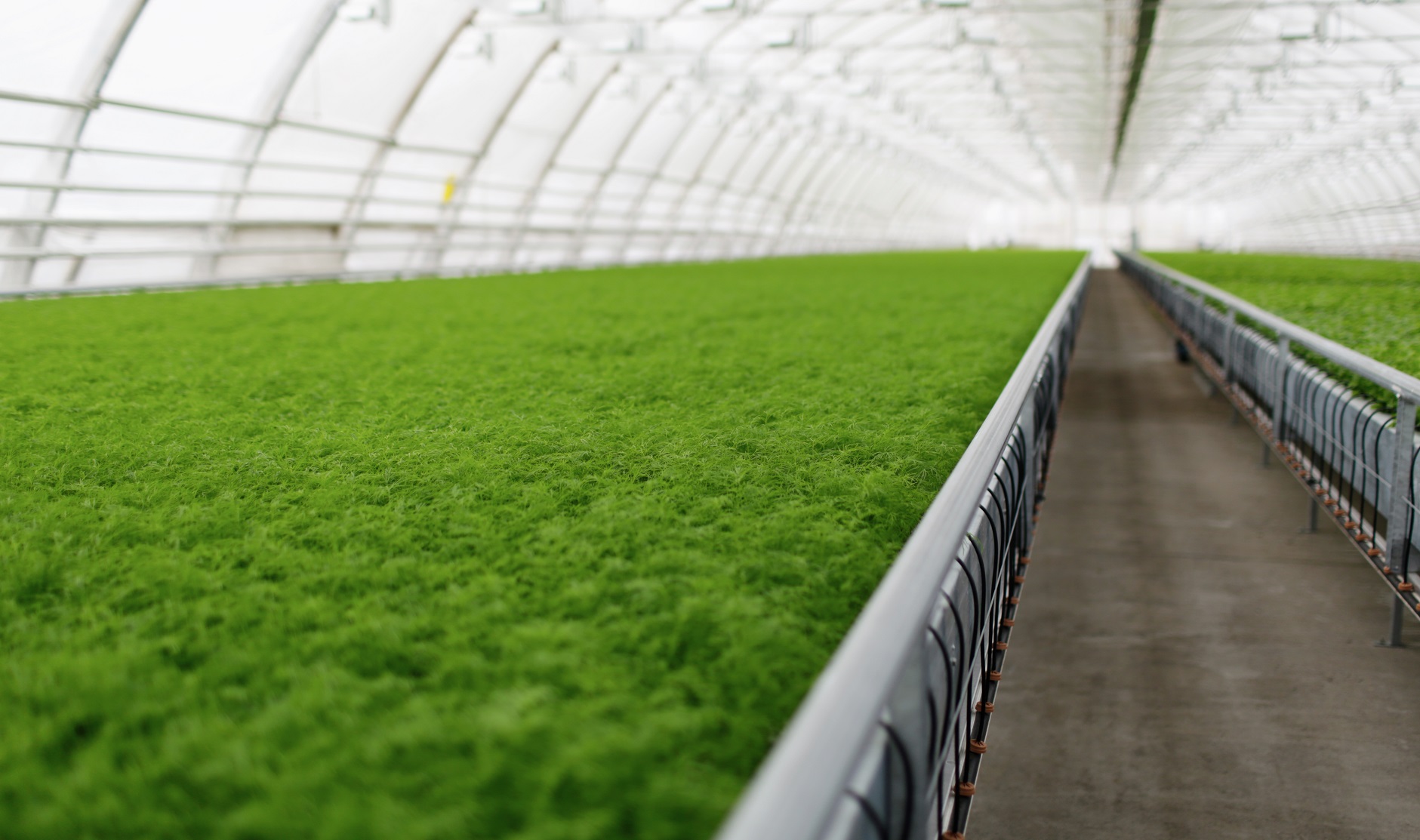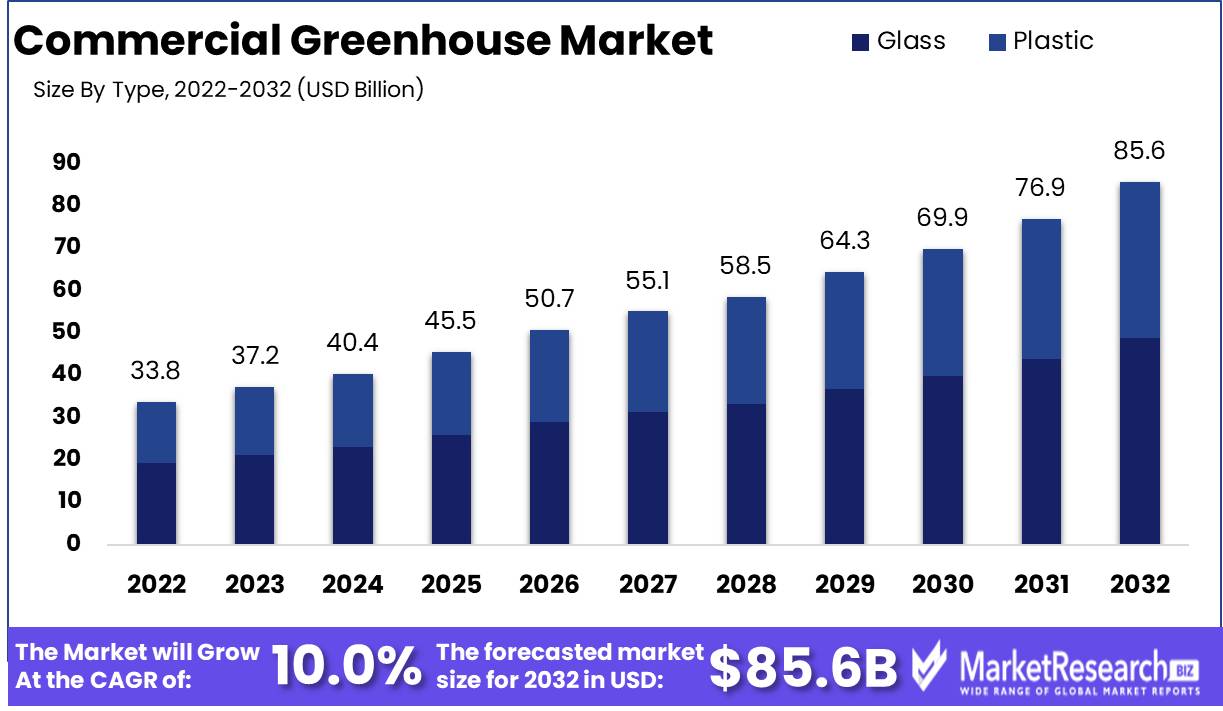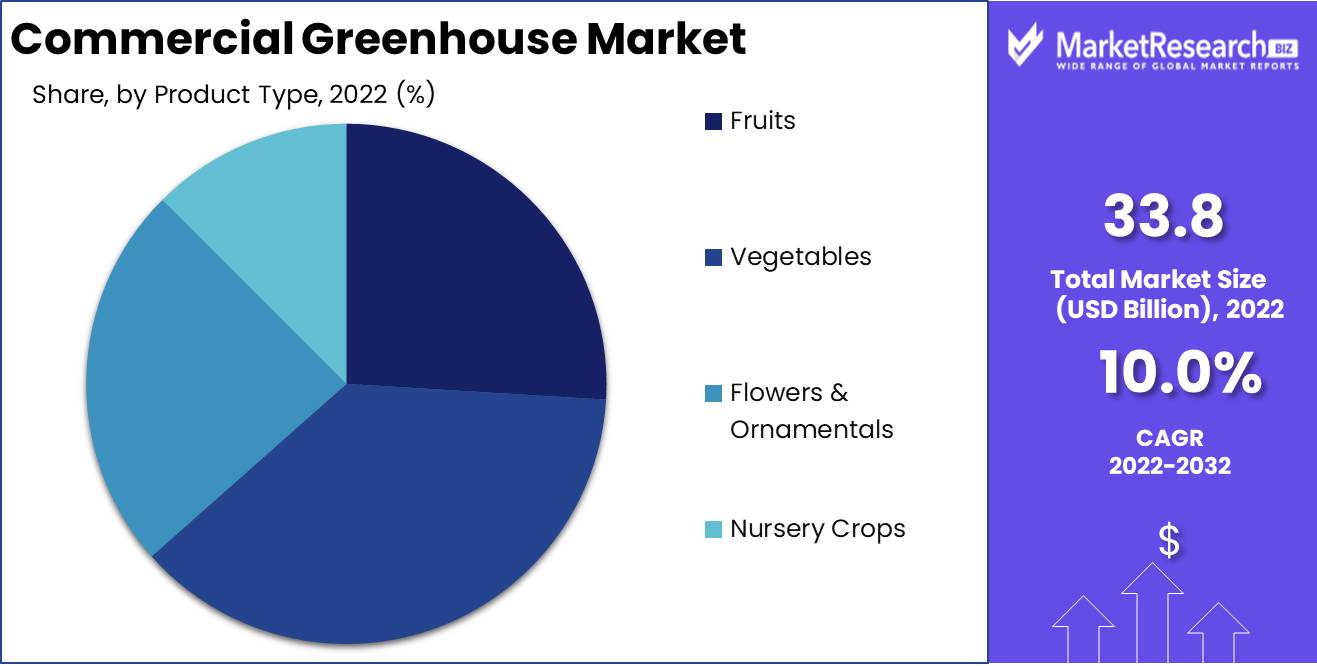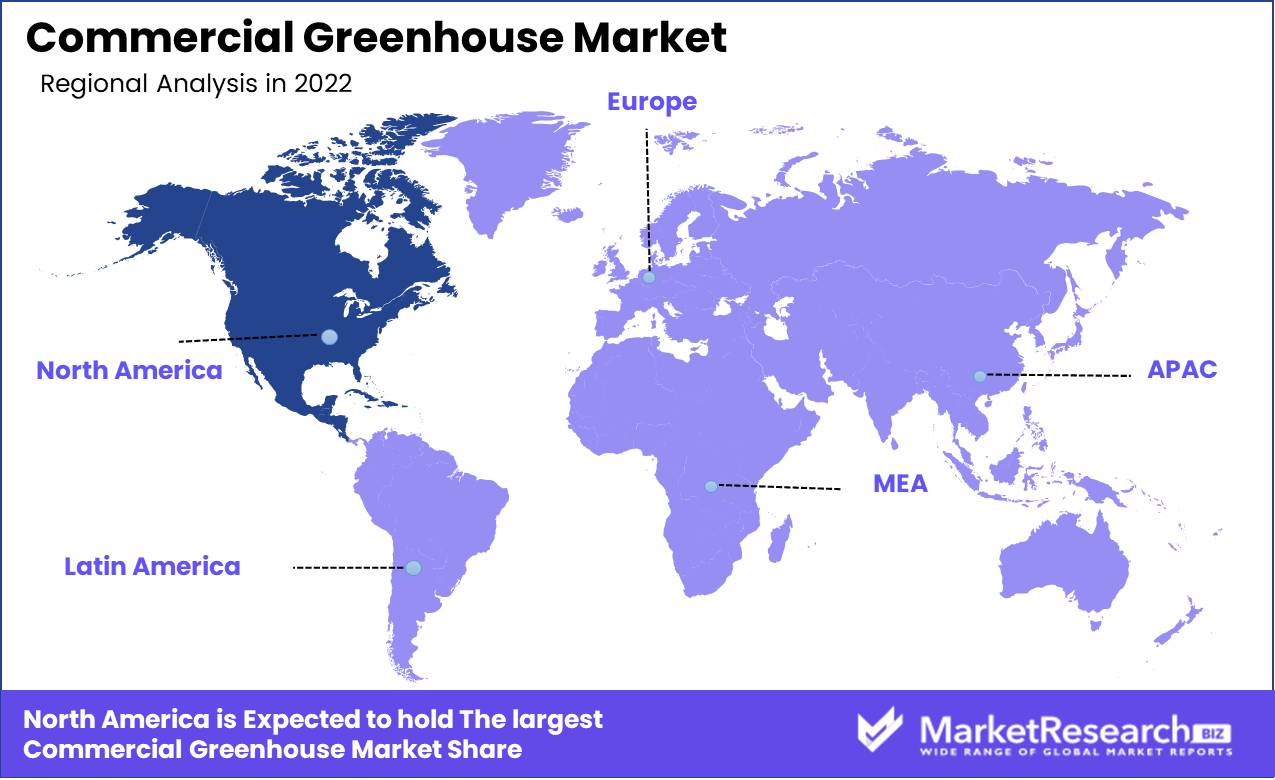
Global Commercial Greenhouse Market By Type (Glass, Plastic), By Product Type (Fruits, Vegetables, Other), By Equipment (Hardware, Software & Services), By Region And Companies - Industry Segment Outlook, Market Assessment, Competition Scenario, Trends, And Forecast 2023-2032
-
38144
-
June 2023
-
166
-
-
This report was compiled by Shreyas Rokade Shreyas Rokade is a seasoned Research Analyst with CMFE, bringing extensive expertise in market research and consulting, with a strong background in Chemical Engineering. Correspondence Team Lead-CMFE Linkedin | Detailed Market research Methodology Our methodology involves a mix of primary research, including interviews with leading mental health experts, and secondary research from reputable medical journals and databases. View Detailed Methodology Page
-
Quick Navigation
Report Overview
The Global Commercial Greenhouse Market size is expected to be worth around USD 85.6 Bn by 2032 from USD 33.8 Bn in 2022, growing at a CAGR of 10.0% during the forecast period from 2023 to 2032.
The commercial greenhouse a vast and intricate web of businesses devoted to the art of designing, constructing, and managing commercial greenhouses, is an awe-inspiring amalgamation of scientific knowledge, technological prowess, and innovative techniques. These state-of-the-art greenhouses, which are brimming with cutting-edge technology and revolutionary techniques, effectively create an artificial realm where crops and plants flourish under precisely controlled conditions.

At its core, the global commercial greenhouse market aspires to provide a sustainable, elite, and financially lucrative alternative to conventional farming paradigms. The greenhouses serve as sanctuaries, protecting crops from external adversities such as pests, diseases, and erratic weather patterns that jeopardize their growth. Furthermore, this visionary market seeks to reduce the agricultural sector's carbon footprint by maximizing the use of renewable energy sources and minimizing waste.
In recent years, the global commercial greenhouse market has witnessed an unprecedented surge in innovation, which has resulted in the birth of revolutionary innovations in the domains of automation, lighting, and irrigation systems. These revolutionary innovations have transformed the landscape of crop production, endowing it with unprecedented precision, unparalleled efficiency, and a reduction in the burdensome need for manual labor, all while increasing the overall yield. In addition to these astounding achievements, the landscape of innovation has also witnessed the emergence of vertical farming, hydroponics, and aquaponics, all of which rise to the occasion and offer inventive solutions to the urgent problems of land scarcity and water scarcity.
By virtue of its immense promise and untapped potential, the global commercial greenhouse market has attracted substantial investments from industry titans such as Village Farms, Inc. and BrightFarms, who have secured vast sums of capital to propel their greenhouse operations to unprecedented heights. These investments have revitalized the realm of research and development, thereby facilitating the incorporation of greenhouse-grown crops into the fabric of mainstream products and services.
The exponential development of this enormous market is fueled by a multitude of factors, including the spiraling demand for pristine, high-quality produce, the ever-increasing urgency to reduce carbon emissions, and the unstoppable march of technological advancement. As this market spreads its tentacles into every aspect of existence, its applications become more pervasive, encompassing the realms of fruit production, vegetable cultivation, ornamental flora care, and even the mysterious realm of cannabis farming.
Numerous industries have identified the limitless potential of the global commercial greenhouse market and are deploying their resources with vigor. In an effort to maximize crop yield and reduce the negative impact of farming practices on our fragile ecosystem, the agriculture industry has begun focusing its efforts on greenhouse operations. Simultaneously, the horticulture industry strives to elevate the cultivation of exquisite ornamental plants and dazzling flowers to previously unattainable heights of beauty.
Nonetheless, despite the brilliance of its achievements, the global commercial greenhouse market cannot evade the substantial ethical considerations it must confront head-on. As is the case with any industry, greenhouses must operate responsibly and sustainably, upholding the values of openness, clarification, and accountability. The establishment of ethical norms requires a steadfast commitment to fair labor practices, environmental sustainability, and the relentless pursuit of waste reduction, ultimately resulting in a tapestry that harmonizes the complexities of commerce with the sacredness of our common humanity.
Driving factors
Growing Demand Success in the Greenhouse
The increase in demand for greenhouse-grown produce is one of the propelling forces behind this optimistic forecast. Growers are recognizing the advantages of offering fresh, locally-grown produce all year long as consumers become more concerned with health and sustainability. This is made possible by the most recent advancements in greenhouse technology, which enable precise control of growing conditions to maximize yields while minimizing waste and energy usage.
Sustainable Expansion Sustainable Products
Additionally, sustainable agricultural practices are a significant factor in this growth. As consumers become more environmentally conscious, they search for products that are grown in an environmentally responsible manner. Greenhouse - Produce grown in a greenhouse saves water, pesticides, and energy. These factors are contributing to the global commercial greenhouse market's significant growth.
Regulatory Challenges Successfully Adapting
Even though the market is in a favorable position, regulatory alterations may have an impact on its future. For instance, regulations regarding the use of pesticides, labor laws, and waste management could change and have an impact on the ability of growers to produce and sell their produce. Growers must therefore remain informed and adaptable to any changes in regulations.
Technological Progresses Profit Maximization
Emerging technologies may also have a significant impact on the global commercial greenhouse market. From advanced sensors and monitoring systems to precision farming tools, technology is advancing rapidly and empowering greenhouse growers to further optimize yields while reducing inputs and costs. These advancements are thrilling and will undoubtedly stimulate industry growth and innovation.
Competitive Vigilance in the Face of Disruptive Factors
In addition, potential disruptors may have an impact on the global commercial greenhouse market's competitive landscape. For instance, new entrants with distinct business models or cultivation techniques could disrupt the conventional greenhouse growing methods. Therefore, it is essential for market leaders to monitor the competition and maintain their agility.
Restraining Factors
Greenhouse Farming is Fueled by Innovative Financing for Small Businesses
Establishing a commercial greenhouse can be a costly endeavor. The construction of the greenhouse, climate control systems, irrigation systems, and other apparatus requires a significant investment. This can be a significant barrier for small enterprises, preventing them from investing in commercial greenhouse farming. However, technological advancements and innovative financing options are making greenhouse farming investments simpler for small farmers. For instance, leasing or renting land, equipment, and sharing facility costs can help reduce the high initial expenditures.
Greenhouse Farming is Revolutionized by Energy-Efficient Technologies
Commercial conservatories require a substantial amount of energy to maintain the ideal climate and lighting conditions for plant growth. The high energy consumption can be a significant obstacle, increasing the greenhouse's operational costs. However, energy-saving technologies such as LED lighting, solar panels, geothermal heating, and ventilation, as well as other renewable energy sources, can help reduce energy consumption and thus operating costs. It is essential to invest in energy-efficient technologies that can help reduce the environmental impact of commercial greenhouse agriculture.
Vertical Expansion of Greenhouse Farming Overcomes Land Restriction
The availability of land suitable for greenhouse cultivation can be a significant obstacle. There are limited land resources in many urban areas, and the available land is often expensive. In rural areas, land availability can be limited, with the majority of land devoted to traditional agricultural methods. By utilizing smaller spaces to cultivate crops, however, vertical farming, rooftop farming, and hydroponic farming methods can help overcome this challenge. These techniques can also be used to increase yields by expanding the production area of commercial greenhouses.
The Advantages of Greenhouse Farming Educating Consumers
Traditional farming methods have been utilized for centuries, and many individuals are skeptical of new methods such as commercial greenhouse farming. They may not comprehend the benefits of utilizing high-tech methods such as hydroponics, which can result in higher yields and superior produce. However, marketing and educating consumers about the benefits of commercial greenhouse farming, such as year-round crop production and the use of sustainable farming practices, can help to overcome these obstacles.
Type Analysis
The glass segment dominates the global commercial greenhouse market, which is evolving rapidly. Glass structures are stylish, sophisticated, and sturdy, protecting plants inside. Global food demand and arable land depletion have fueled the commercial greenhouse market. Farmers globally choose glass segment greenhouses because they yield more.
Growing economies are adopting glass-segment greenhouses. In emerging nations, food demand and urbanization have restricted acreage, making glass-segment greenhouses suitable. These governments aggressively promote greenhouses to enhance food production. Arid locations can grow crops in glass-segment greenhouses. Advanced greenhouse technologies boost farmer production and profitability, attracting more customers.
Glass-segment greenhouses are becoming more popular with consumers. Locally grown fruit is gaining popularity, thus consumers are prepared to pay extra for glass-segment greenhouse-grown veggies and herbs. Organic produce demand is driving the glass segment greenhouse market.
Consumers also worry about arable land depletion and the environmental impact of farming pesticides. Glass-segment greenhouses let farmers grow food without chemicals, lowering their carbon footprint. The market for glass segment greenhouses has increased as more people become ecologically concerned.
Due to its benefits, the glass segment of the global commercial greenhouse market is expected to develop the fastest. Glass is a great greenhouse material since it's robust, energy-efficient, and light-absorbing. Glass segment greenhouses have higher yields because they transmit more light than plastic or polycarbonate.
Product Type Analysis
The global commercial greenhouse market is dominated by the vegetable segment. With population expansion and urbanization, vegetable demand is rising. The commercial greenhouse market's vegetable segment has grown due to organic farming and local produce.
The commercial greenhouse market's vegetable segment is growing as emerging nations develop. To boost food production, reduce waste, and boost crop exports, emerging nations are investing in advanced farming methods. The vegetable segment yields more than traditional farming.
Health-conscious consumers want fresh, local produce. The greenhouse market's vegetable segment provides pesticide-free crops year-round. The greenhouse market vegetable segment has grown because consumers are ready to pay more for high-quality products.
Due to urbanization, rising demand for locally sourced products, and declining arable land, the vegetable segment of the global commercial greenhouse market is expected to develop the fastest. Farmers like greenhouses because they increase yields, and quality, and reduce waste. The greenhouse market's vegetable segment has grown due to hydroponics, aeroponics, and fertigation.

Equipment Analysis
The Global Commercial Greenhouse Market is dominated by the Software & Services segment. Commercial greenhouse software and services help farmers run their crops more efficiently. Many greenhouse technology software solutions monitor climate, water usage, and nutrient levels.
Emerging economies drive the usage of software and services in the commercial greenhouse market. Modern farming methods that enhance production and efficiency are needed due to rising food demand and declining arable land. Advanced software allows farmers to remotely monitor their crops and make data-driven yield-optimizing decisions.
Consumers want produce that is chemical-free, responsibly farmed, and low-carbon. Software and services in the commercial greenhouse market allow farmers to grow crops without pesticides and reduce their carbon impact. The greenhouse market software and services segment is growing because consumers are prepared to pay more for food that fits these standards.
The software and services segment of the global commercial greenhouse market is expected to develop the fastest because to the growing usage of advanced technology and the necessity for data-driven decision-making to maximize efficiency. Artificial intelligence and machine learning have improved greenhouse software yields and efficiency. Urbanization and food demand have increased commercial greenhouse market demand for software and services.
Key Market Segments
By Type
- Glass
- Plastic
By Product Type
- Fruits
- Vegetables
- Flowers & Ornamentals
- Nursery Crops
By Equipment
- Hardware
- Software & Services
Growth Opportunity
Stable Growth Greenhouses for Business Change Food Production
The greenhouse business is crucial to sustainable food production as climate change progresses. Commercial greenhouses today meet the demand for locally sourced, fresh, and organic vegetables while reducing environmental impact. With an estimated market worth of $25 billion, the commercial greenhouse business is primed for exponential growth.
Energy-Efficient Solutions Insulated Greenhouses Save
Commercial greenhouses' affordability and energy efficiency fuel demand and market growth. Greenhouse operators must save expenses while increasing crop yields and quality. The development of greenhouse designs that maximize energy efficiency and lower operating costs has been made possible by advances in technology and material science. Greenhouses made of insulated panel materials save energy and provide ideal growing conditions. These greenhouses save operators money with energy-efficient lighting and environmental control systems.
Smart Tech Transforms Greenhouses for Efficiency and Sustainability
Smart greenhouse technology has enabled automation. Smart greenhouse technology uses IoT sensors and automated environmental control systems to maximize growing conditions and reduce operational costs. Sensors regulate temperature, humidity, and CO2 levels in real-time to maximize growing conditions. Automated lighting, water, and nutrient systems boost agricultural yields and quality while lowering expenses. Smart technology has transformed the greenhouse business, enabling sustainable and efficient farming.
Urban Greenhouses Proliferate Fresh Produce
Urban greenhouse expansion fuels commercial greenhouse growth. The demand for locally sourced, fresh, and organic produce has increased as the world's population continues to move into urban areas. Urban greenhouses, smaller and closer to consumers, suit this demand. Urban greenhouses cut transit expenses, carbon emissions, and fresh produce costs. Vertical farming and hydroponic systems have made urban farming more accessible, giving entrepreneurs and producers new opportunities.
Latest Trends
Evolving Greenhouse Trends
The global market for commercial greenhouses is continuously evolving and has undergone significant transformations in the past few years. Hydroponics, vertical farming, energy-saving materials, and organic/sustainable practices are the main market trends that have emerged as the primary drivers for this market. These trends are influencing the future of commercial greenhouse production and the way modern agriculture is practiced across the globe.
Hydroponics Revolutionizes Agriculture
Hydroponics is a soilless plant cultivation technique that has acquired popularity in recent years. Instead of soil, plants are grown in nutrient-rich water. This method has several advantages, including increased crop yields, decreased water usage, and enhanced plant health. In terms of space utilization, hydroponic systems are more effective than conventional cultivation, resulting in greater crop yields per unit of land.
Vertical Farming Revolutionizes Greenhouses
Vertical farming is an emerging market trend within the commercial greenhouse industry. Using artificial lighting, temperature control, and humidity modulation, it involves growing crops in stacked layers. This method has a number of advantages over conventional farming, including increased crop yields, year-round production, and decreased water consumption.
Energy-saving Materials Upgrade Greenhouses
In commercial greenhouse construction, energy-efficient materials are becoming increasingly popular. These materials include insulation, solar panels, and illumination systems that are energy-efficient. The use of these materials can considerably reduce the energy consumption of greenhouses, resulting in lower operating costs and a smaller carbon footprint. It is anticipated that the use of energy-efficient materials will increase in the future years as they become more affordable.
Greenhouse Demand is Rising
Finally, organic and sustainable practices are fueling demand for commercial greenhouses that produce eco-friendly crops. These practices include using natural insect control methods, decreasing water consumption, and utilizing renewable energy sources. Consumers are becoming increasingly aware of the environmental impacts of modern agriculture, and many are prepared to pay a premium for locally grown, environmentally friendly crops.
Regional Analysis
North America has been dominating the commercial greenhouse market because it is one of the most technologically advanced regions in the globe. People are becoming more environmentally conscious in our time. In order to reap the benefits of controlled settings in agriculture, there has been an increase in interest in the usage of greenhouses. The commercial greenhouse market has grown rapidly due to demand.
North America, a technologically advanced region, has improved greenhouse farming. The region's greenhouse manufacturers have been able to invest in cutting-edge technology to build sophisticated systems to improve crop development, energy efficiency, CO2 control, and other benefits. North America leads the commercial greenhouse market with this advanced technology.
North America dominates the commercial greenhouse market because of its high-quality crops. Farmers in the region can maintain perfect climatic and environmental conditions for crops to flourish thanks to modern greenhouse technologies. Consumer-friendly, disease-free crops result. North American farmers use advanced hydroponic and aeroponic systems to maximize resource efficiency and minimize pesticide and herbicide use.
Government backing boosts North America's commercial greenhouse market. The region's governments have actively supported farmers with grants, subsidies, and advantageous laws. These rules and subsidies allow greenhouse farmers to invest in advanced technologies and increase crop yields. The assistance has also helped develop R&D tools, top-notch training programs, and regulatory instruments, making North America's commercial greenhouse industry one of the world's best.

Key Regions and Countries
North America
- US
- Canada
- Mexico
Western Europe
- Germany
- France
- The UK
- Spain
- Italy
- Portugal
- Ireland
- Austria
- Switzerland
- Benelux
- Nordic
- Rest of Western Europe
Eastern Europe
- Russia
- Poland
- The Czech Republic
- Greece
- Rest of Eastern Europe
APAC
- China
- Japan
- South Korea
- India
- Australia & New Zealand
- Indonesia
- Malaysia
- Philippines
- Singapore
- Thailand
- Vietnam
- Rest of APAC
Latin America
- Brazil
- Colombia
- Chile
- Argentina
- Costa Rica
- Rest of Latin America
Middle East & Africa
- Algeria
- Egypt
- Israel
- Kuwait
- Nigeria
- Saudi Arabia
- South Africa
- Turkey
- United Arab Emirates
- Rest of MEA
Key Players Analysis
The global market for commercial greenhouses is highly competitive, with numerous essential players. These companies manufacture, distribute, and sell conservatories and greenhouse-related products. Some of the market's leading competitors include:
The Swedish company Heliospectra AB designs and manufactures high-quality LED lighting systems for indoor agricultural and greenhouse applications.
Rough Brothers Inc. is a greenhouse manufacturer and installer based in the United States that specializes in design-to-completion greenhouse projects.
Lexus Corporation is an American company that specializes in the design and manufacture of commercial greenhouses, hydroponic systems, and related products of the highest quality. Harnois Greenhouses is a Canadian company that designs and manufactures commercial greenhouses, shade structures, and other related products.
Richel Group, based in France, is a prominent manufacturer of commercial greenhouses, high tunnels, and related products.
Agra Tech Inc. is a company situated in the United States that specializes in the design, manufacture, and installation of commercial greenhouses, hydroponic systems, and related products.
These companies are well known for their innovative products and outstanding customer service. They are committed to providing high-quality products and services to their customers and are continually expanding their product lines to satisfy the rising demand for innovative greenhouse solutions. Given that the global commercial greenhouse market is anticipated to continue expanding, these companies will play a significant role in defining the industry's future.
Top Key Players in Commercial Greenhouse Market
- Berry Global (US)
- Signify Holding (Netherlands)
- Heliospectra AB (Sweden)
- Plastika Kritis (Greece)
- Everlight Electronics (Taiwan)
- Richel Group (France)
- Argus Control Systems (Canada)
- Certhon (The Netherlands)
- Logiqs BV (The Netherlands)
- LumiGrow (US)
- Agra-tech Inc. (US)
- Rough Brothers Inc .(US)
- Hort Americas (US)
- Stuppy Greenhouse (US)
- The Glasshouse Company (Australia)
- DeCloet Manufacturing Ltd (Canada)
- Euro progress (Italy)
- Luiten Greenhouses (New Zealand)
- Sotrafa (Spain)
- Nobutec BV (The Netherlands)
- Ammerlaan Constructions (The Netherlands)
- Ludy Greenhouse (US)
- Saveer Biotech Ltd (India)
- Harford (New Zealand)
- Other Key Players
Recent Development
- In 2023, Artificial intelligence (AI) and machine learning (ML) technologies have made their way into commercial greenhouses by the year 2023.
- In 2022, The implementation of intelligent irrigation systems, and water management in commercial greenhouses has improved substantially by 2022.
- In 2021, Designs for greenhouses that are sustainable and energy-efficient are becoming increasingly popular.
- In 2020, The incorporation of hydroponics and vertical cultivation techniques into commercial greenhouses has garnered significant attention.
- In 2019, Advanced Climate Control Systems In recent years, significant progress has been made in the creation of advanced climate control systems for commercial greenhouses.
Report Scope:
Report Features Description Market Value (2022) USD 33.8 Bn Forecast Revenue (2032) USD 85.6 Bn CAGR (2023-2032) 10.0% Base Year for Estimation 2022 Historic Period 2016-2022 Forecast Period 2023-2032 Report Coverage Revenue Forecast, Market Dynamics, COVID-19 Impact, Competitive Landscape, Recent Developments Segments Covered By Type (Glass, Plastic), By Product Type (Fruits, Vegetables, Flowers & Ornamentals, Nursery Crops), By Equipment (Hardware, Software & Services) Regional Analysis North America – The US, Canada, & Mexico; Western Europe – Germany, France, The UK, Spain, Italy, Portugal, Ireland, Austria, Switzerland, Benelux, Nordic, & Rest of Western Europe; Eastern Europe – Russia, Poland, The Czech Republic, Greece, & Rest of Eastern Europe; APAC – China, Japan, South Korea, India, Australia & New Zealand, Indonesia, Malaysia, Philippines, Singapore, Thailand, Vietnam, & Rest of APAC; Latin America – Brazil, Colombia, Chile, Argentina, Costa Rica, & Rest of Latin America; Middle East & Africa – Algeria, Egypt, Israel, Kuwait, Nigeria, Saudi Arabia, South Africa, Turkey, United Arab Emirates, & Rest of MEA Competitive Landscape Berry Global (US), Signify Holding (Netherlands), Heliospectra AB (Sweden), Plastika Kritis (Greece), Everlight Electronics (Taiwan), Richel Group (France), Argus Control Systems (Canada), Certhon (The Netherlands), Logiqs BV (The Netherlands), LumiGrow (US), Agra-tech Inc. (US), Rough Brothers Inc .(US), Hort Americas (US), Stuppy Greenhouse (US), The Glasshouse Company (Australia), DeCloet Manufacturing Ltd (Canada), Europrogress (Italy), Luiten Greenhouses (New Zealand), Sotrafa (Spain), Nobutec BV (The Netherlands), Ammerlaan Constructions (The Netherlands), Ludy Greenhouse (US), Saveer Biotech Ltd (India), Harford (New Zealand), Other Key Players Customization Scope Customization for segments, region/country-level will be provided. Moreover, additional customization can be done based on the requirements. Purchase Options We have three licenses to opt for: Single User License, Multi-User License (Up to 5 Users), Corporate Use License (Unlimited User and Printable PDF) -
-
- Berry Global (US)
- Signify Holding (Netherlands)
- Heliospectra AB (Sweden)
- Plastika Kritis (Greece)
- Everlight Electronics (Taiwan)
- Richel Group (France)
- Argus Control Systems (Canada)
- Certhon (The Netherlands)
- Logiqs BV (The Netherlands)
- LumiGrow (US)
- Agra-tech Inc. (US)
- Rough Brothers Inc .(US)
- Hort Americas (US)
- Stuppy Greenhouse (US)
- The Glasshouse Company (Australia)
- DeCloet Manufacturing Ltd (Canada)
- Euro progress (Italy)
- Luiten Greenhouses (New Zealand)
- Sotrafa (Spain)
- Nobutec BV (The Netherlands)
- Ammerlaan Constructions (The Netherlands)
- Ludy Greenhouse (US)
- Saveer Biotech Ltd (India)
- Harford (New Zealand)
- Other Key Players




